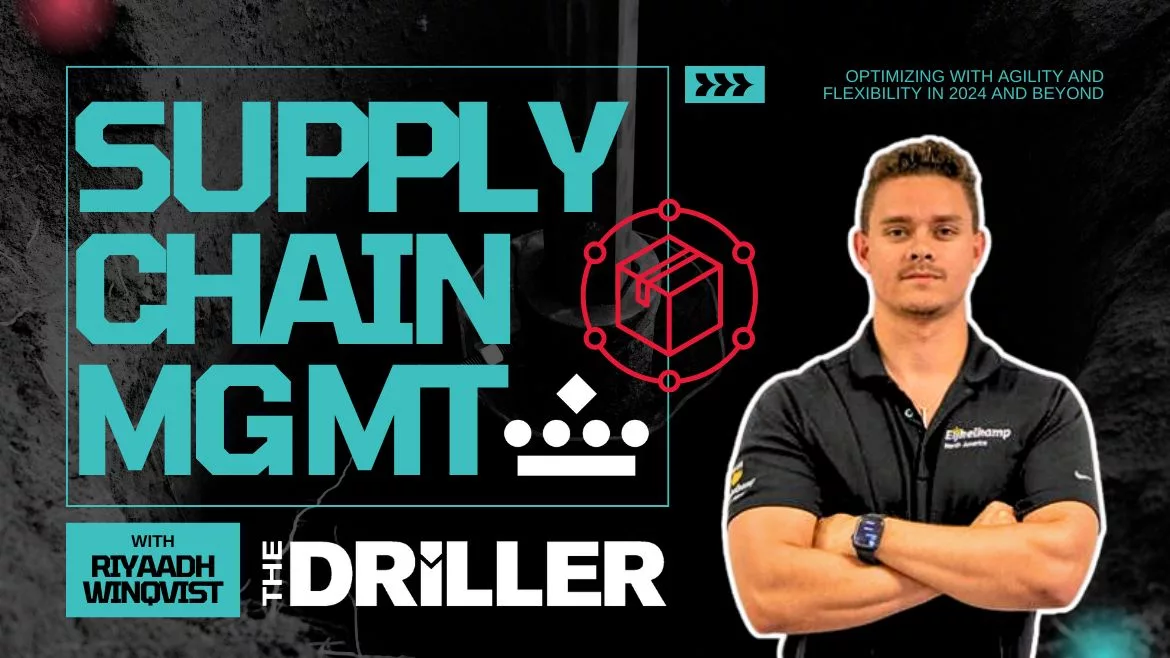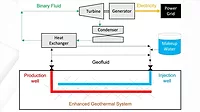From Bottlenecks to Breakthroughs: Supply Chain Optimization Insights from a Rising Star
Discover how to optimize your drilling supply chain with Riyaadh Winqvist!

The drilling industry, like many others, faces unique challenges in managing supply chains effectively. Even five years after COVID-19 struck the market head-on, the effects are still rearing their ugly heads. From bottlenecks and sustainability issues to finding reliable suppliers and developing solid relationships, the process of optimizing your supply chain—especially in an industry as comprehensive and timely as drilling—is crucial and requires a strong understanding of what metrics to track and what makes a reliable supplier.
Fortunately, as the topic of supply chain optimization has only continued to expand due to unforeseen economic climate shifts, new leaders are entering the ring and providing key insights from a youthful perspective. Riyaadh Winqvist, the Inside Sales & Logistics Coordinator at Eijkelkamp North America, is one of these new faces in the field with invaluable insights to share. Recently, I was able to sit down with this innovative supply chain management authority and Winqvist shed light on current strategies and the future of supply chain optimization in the sector.
The Current State of Supply Chain in Drilling
The COVID-19 pandemic highlighted vulnerabilities in global supply chains across all sectors, leading to a reevaluation of strategies and an increased focus on resilience and adaptability. According to a survey by EY, only 2% of companies believed they were prepared for the pandemic, while severe disruptions affected 57%, and 72% of brands reported a negative effect.
In the drilling industry, disruptions were felt in delayed shipments, shortages of essential materials, and challenges in maintaining operations in compliance with health regulations. These disruptions prompted companies to invest more heavily in technology and diversification of their supply base to mitigate future risks.
Despite Winqvist’s relatively short tenure in the industry, the Inside Sales & Logistics Coordinator brings a fresh perspective on the robust state of supply chains. "The current state is pretty strong," he asserts, "due to the fact that companies are recognizing the importance of adopting integrated supply chain management strategies." This approach focuses on efficiency, sustainability, and cost reduction, ensuring smooth operations across the board.
Within the geothermal drilling sector, the supply chain is as critical as in any other part of the energy industry. According to the Clean Energy Manufacturing initiative, the geothermal industry provides extensive opportunities for manufacturers due to its need for a wide array of equipment and materials. For instance, the drilling of deep wells to access geothermal energy requires durable tanks, powerful pumps, high-performance motors, and robust piping systems—components that are also common in oil and natural gas drilling.
The specificity of geothermal systems, where heat exchange fluids like antifreeze or brine solutions circulate through subsurface tubing, calls for specialized materials that ensure longevity and efficiency under extreme conditions. Manufacturers who excel in producing high-quality pipes and fluids can find significant opportunities in this niche market. Companies that can innovate in material science and engineering to extend the lifespan and efficiency of these systems will benefit from long-term partnerships and contracts.
Moreover, the end equipment, such as geothermal furnaces, which convert subsurface heat to usable energy, involves a complex supply chain involving numerous suppliers and vendors. With prominent players like Water Furnace and ClimateMaster leading the market in the U.S., there is a vibrant ecosystem for new entrants and existing manufacturers to innovate and collaborate. These relationships are crucial for sustaining growth and supporting the expansion of geothermal energy projects, which are becoming increasingly vital in the push for clean and sustainable energy solutions.
Thus, the geothermal drilling supply chain not only mirrors the complexities seen in other energy sectors but also offers unique challenges and opportunities that require targeted strategies and solutions. As the industry grows, driven by global shifts toward sustainable energy, the supply chain will continue evolving, presenting challenges and significant opportunities for those ready to innovate and adapt.
As Winqvist emphasizes, a supply chain management strategy focused on integration and optimization is the key to the future of the sector as well. Integrated supply chain management strategies involve a comprehensive approach to managing the flow of goods, information, and finances across the entire supply chain. These strategies emphasize collaboration among all stakeholders, including suppliers, manufacturers, distributors, and customers, to enhance efficiency and responsiveness.
Key components include implementing advanced technology for real-time data analytics and communication facilitating better decision-making and forecasting. Additionally, sustainability practices are integrated to minimize environmental impact and improve resource utilization. This holistic view of the supply chain aims to optimize operations, reduce costs, and improve service delivery by synchronizing demand planning with production and distribution, ensuring that the entire process, from raw material procurement to delivery of the final product, is streamlined and effective.
Navigating Bottlenecks
Every industry encounters its share of challenges, and drilling is no exception. Winqvist identifies several significant bottlenecks, including transportation delays, inventory management issues, and stringent environmental regulations. Additionally, global factors like trade restrictions and tariffs play a crucial role due to the industry's international scope. "These bottlenecks can disrupt the flow of materials and equipment, affecting overall operations," Winqvist explains.
But how can a small drilling business owner truly mitigate these risks and eliminate bottlenecks well before they affect the drilling projects a company acquires? To answer this, Winqvist highlights the need to implement predictive analysis applications and the close tracking of key performance indicators (KPIs) and supplier relations.
Predictive analysis applications serve as a vital tool in navigating the complexities of the drilling industry by allowing companies to forecast future trends and potential disruptions. By leveraging historical data, these tools can predict outcomes such as demand spikes, equipment failures, or supply shortages, enabling proactive adjustments. For instance, predictive analytics can help a drilling company anticipate the need for additional drill bits or other critical supplies based on projected usage rates and order them in advance, thus avoiding costly delays. This is one of the most effective ways to eliminate bottlenecks before they even occur.
Winqvist also emphasizes the importance of maintaining robust supplier relations. Establishing strong, communicative relationships with suppliers ensures a more reliable flow of materials and parts. Nearly 50% of supplier collaborations fail, according to Forbes. Regular interactions and feedback help both the drilling company and supplier understand and align with each other's operational needs and capacities.
This collaborative approach not only smoothens the supply process but also creates avenues for quicker solutions when disruptions occur. Localizing and diversifying your supply chain is a good way to ensure that even when a supplier isn’t working out, you can find a quick solution to the problem.
Key performance indicators (KPIs) are essential metrics that help monitor the efficiency and effectiveness of supply chain operations. By tracking KPIs such as on-time delivery rates, inventory turnover, and supplier response times, drilling companies can gain insights into their supply chain's health and pinpoint areas needing improvement. For example, if a particular supplier frequently misses delivery deadlines, it might indicate the need to diversify suppliers or address logistical issues. Monitoring these indicators helps companies make informed decisions that enhance operational resilience and reduce the likelihood of encountering bottlenecks.
In essence, the integration of predictive analytics, strong supplier relationships, and diligent monitoring of KPIs form a comprehensive approach to managing the supply chain. These strategies equip drilling companies with the tools necessary to anticipate, adapt to, and efficiently navigate the challenges that arise within dynamic market conditions, ensuring continuous operation without interruption.
Leveraging Technology for Optimization
One of the key strategies for managing these challenges is leveraging advanced technology. As stated previously, Winqvist highlights the use of predictive analytics and demand forecasting, which have proven effective at Eijkelkamp North America. "Our team developed an effective solution for container shipping that minimized carbon emissions and costs, aligning with our commitment to sustainability," he shares. This approach not only addresses environmental concerns but also enhances efficiency.
However, other forms of technology, such as AI, KPI trackers, and procurement applications, can also be utilized for supply chain optimization. By balancing all of the above, you can ensure your drilling supply chain is prepared to weather any storm.
The Role of Sustainability
Sustainability has increasingly become a cornerstone of supply chain management. Approximately 30% of supply chain professionals say their companies have specific sustainability targets for their suppliers. This number continues to increase as more young people join the workforce and demand sustainability in business.
Winqvist notes that sustainable practices lead to long-term cost savings by reducing waste and optimizing resource use. "Having a sustainable supply chain also helps mitigate risks associated with environmental and social factors, improving the company's reputation and potentially attracting more business," he adds.
This is particularly true given the new Gen Z workforce as the statistics showcase just how invested in sustainability they are both as consumers as well as employees.
91% of Gen Z say they want to buy from sustainable companies.
77% are willing to pay more for sustainable products and services.
Over half of Gen Zs and millennials say they research a brand's environmental impact and policies before accepting a job offer.
Around half of Gen Zs (54%) and millennials (48%) say they and their colleagues are pressuring their employers to take action on sustainability.
To decrease employee turnover, save money, and optimize your supply chain, it's time you considered sustainability a priority.
Preparing for the Future
Looking forward, Winqvist is optimistic about the role of innovation and collaboration in shaping the future of supply chain management. "Artificial intelligence will likely automate many of our current processes, radically changing how we manage supply chains," he predicts. This shift will require current and future supply chain professionals to adapt to new technologies and methods rapidly.
However, even today, many companies are glad to take on the challenge in hopes of becoming a more optimized and streamlined version of their former selves. In fact, it is so enticing that AI in the supply chain market is expected to reach USD 10.78 billion by 2025. Nearly 50% of businesses consider AI as a potential solution for integrating and managing supply chain activities.
Overall, however, the most exciting aspect of the future of supply chain optimization stands in the localization and nurturing of supplier relationships. By working closely together to develop a failproof system, drilling companies and suppliers alike can finally achieve a streamlined dynamic that can withstand bottlenecks, economic climate shifts, and, yes, even pandemics of varying proportions.
Advice for Small Business Owners
To finish off this interview, I chose to ask the young leader the questions our small drilling business owners far too often are unable to ask. For these humble brand owners seeking to optimize their supply chains, Winqvist recommends building strong relationships with suppliers and leveraging technology to improve efficiency and responsiveness. "Understanding the flow of materials and maintaining flexible, efficient operations are key to navigating the complexities of today's economic climate," he advises.
At the end of the day, the name of the game is flexibility and agility. An agile supply chain is a successful one, and the brands that nurture and track their supply chains are the ones capable to withstand just about anything.
As the drilling industry continues to evolve, the integration of advanced technologies and sustainable practices will likely play pivotal roles in shaping effective supply chain strategies. Fortunately, with experts like Winqvist leading the charge, the sector appears well-positioned to tackle future challenges head-on.
Stay tuned for a full-length feature with Riyaadh Winqvist as part of the Emerging Drillers series!
Looking for a reprint of this article?
From high-res PDFs to custom plaques, order your copy today!







